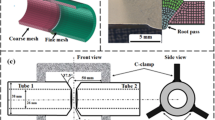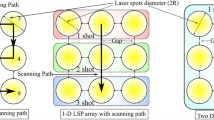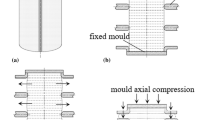Abstract
In the present work, welding heat distribution state and its influence on welding deformation were investigated by adjusting the laser welding sequence, and then the thin plate welding parameters were optimized. Numerical simulation and experiment were used to investigate the welding deformation of laser welding 1-mm 6061 aluminum alloy thin plate. Numerical simulation was performed using Abaqus and Fortran for sequential coupled temperature–displacement analysis and experimental validation. The numerical simulation was used to quantitatively compare the welding deformation and residual stress caused by single-weld continuous welding and single-weld segmented skip welding. Results show that the transverse shrinkage of the single-weld segmented skip welding was smaller, the longitudinal shrinkage control was better, and the out-of-plane deformation was lower than those in single-weld continuous welding. Compared with single-weld continuous welding, the transverse shrinkage of segmented skip welding decreased by 7.14%, the average longitudinal shrinkage decreased by 34%, and the deflection deformation decreases by 12.9%. The adjustment of thermal distribution improved the generation and release of residual stress. The peak stress value at location 3 was reduced by 12% for segmented skip welding. For longitudinal residual stress, the high stress zone appeared in the weld center of segmented skip welding, but the average longitudinal residual stress decreased by 7.8% from 237.4 to 218.7 MPa.
























Similar content being viewed by others
Data availability
The data used to support the findings of this study are available from the corresponding author upon request.
Code availability
Not applicable.
References
Deng D, Murakawa H (2008) FEM prediction of buckling distortion induced by welding in thin plate panel structures. Comput Mater Sci 43(4):591–607
Nélias D, Jullien JF, Boitout F, Dischert L, Noe X (2011) Finite element analysis of metallurgical phase transformations in AA 6056–T4 and their effects upon the residual stress and distortion states of a laser welded T-joint. Int J Press Vessels Pip 88(1):45–56
Tsao LC, Tsai T, C, Wu C. S, Chuang T. H, (2001) Brazeability of the 6061–T6 aluminum alloy with Al-Si-20Cu-based filler metals. J Mater Eng Perform 10(6):705–709
Sun J, Liu X, Tong Y, Deng D (2014) A comparative study on welding temperature fields, residual stress distributions and deformations induced by laser beam welding and CO2 gas arc welding. Mater Des 63:519–530
Tan D, Zhang B, Qiu J (2021) Ultrafast laser direct writing in glass: thermal accumulation engineering and applications. Laser Photonics Rev 15(9):2000455
Zang Z, Zeng X, Du J, Wang M, Tang X (2016) Femtosecond laser direct writing of microholes on roughened ZnO for output power enhancement of InGaN light-emitting diodes. Opt Lett 41(15):3463–3466
Chambonneau M, Grojo D, Tokel O, Ilday FÖ, Tzortzakis S, Nolte S (2021) In-volume laser direct writing of silicon—challenges and opportunities. Laser Photonics Rev 15:2100140
Chambonneau M, Li Q, Fedorov VY, Blothe M, Schaarschmidt K, Lorenz M, Nolte S (2021) Taming ultrafast laser filaments for optimized semiconductor–metal welding. Laser Photonics Rev 15(2):2000433
Lu Y, Zhu S, Zhao Z, Chen T, Zeng J (2020) Numerical simulation of residual stresses in aluminum alloy welded joints. J Manuf Process 50:380–393
Li Y, Zou W, Lee B, Babkin A, Chang Y (2020) Research progress of aluminum alloy welding technology. Int J Adv Manufacturing Technol 109(5):1207–1218
Ma N, Huang H, Murakawa H (2015) Effect of jig constraint position and pitch on welding deformation. J Mater Process Technol 221:154–162
Wei Zhang (2018) Microstructure and fatigue properties of high-frequency micro-vibration aluminum alloy laser welded joints. Shanghai University of Engineering Technology
Genyu C, Dongyuan J, WangBin CB, Yingxin Z, Jingru W (2021) Research on deformation control of ultrasonic-assisted laser welding of 6061 aluminum alloy. Laser Technology 45(05):541–547
Zhang Y, Ying Y, Liu X, Wei H (2016) Deformation control during the laser welding of a Ti6Al4V thin plate using a synchronous gas cooling method. Mater Des 90:931–941
Ueda Y, Murakawa H, Ma N (2012) Welding deformation and residual stress prevention. Elsevier
Zain-ul-Abdein M, Nelias D, Jullien JF, Deloison D (2009) Prediction of laser beam welding-induced distortions and residual stresses by numerical simulation for aeronautic application. J Mater Process Technol 209(6):2907–2917
Derakhshan ED, Yazdian N, Craft B, Smith S, Kovacevic R (2018) Numerical simulation and experimental validation of residual stress and welding distortion induced by laser-based welding processes of thin structural steel plates in butt joint configuration. Opt Laser Technol 104:170–182
Song K, Xuhe Z, Liang X, Haifeng Y, Hui C (2021) Numerical simulation on laser hybrid welding deformation of side walls of train body based on inherent strain method. Weld Join 12:42–47
Khoshroyan A, Darvazi AR (2020) Effects of welding parameters and welding sequence on residual stress and distortion in Al6061-T6 aluminum alloy for T-shaped welded joint. Trans Nonferrous Met Soc of China 30(1):76–89
Ramiarison H, Barka N, Pilcher C, Stiles E, Larrimore G, Amira S (2021) Weldability improvement by wobbling technique in high power density laser welding of two aluminum alloys: Al-5052 and Al-6061. J Laser Appl 33(3):032015
Lang Q, Zhang X, Song G, Liu L (2021) Effects of different laser power and welding speed on the microstructure and mechanical properties of TRIP joints in laser-TIG arc hybrid lap filler wire welding. Mat Today Commun 29:102925
Examilioti TN, Kashaev N, Enz J, Klusemann B, Alexopoulos ND (2020) On the influence of laser beam welding parameters for autogenous AA2198 welded joints. Int J Adv Manufacturing Technol 110(7):2079–2092
Cheng J (2017) Numerical simulation of welding process. Science Press, Beijing, pp 78–89
Deng D, Zhou Y, Bi T, Liu X (2013) Experimental and numerical investigations of welding distortion induced by CO2 gas arc welding in thin-plate bead-on joints. Mater Des 52:720–729
Deng D, Kiyoshima S (2010) Numerical simulation of residual stresses induced by laser beam welding in a SUS316 stainless steel pipe with considering initial residual stress influences. Nucl Eng Des 240(4):688–696
Ueda Y, Murakawa H (1985) Applications of computer and numerical analysis techniques in welding research. Mater Des 6(3):103–111
Wang J (2013) Investigation of buckling distortion of ship structure due to welding assembly using inherent deformation theory. Osaka University
Deshuai Yang (2014) Microstructure and mechanical properties of 6061 aluminum alloy laser welded joints. Shandong University
Masubuchi K (2013) Analysis of welded structures: residual stresses, distortion, and their consequences, vol 33. Elsevier
Deng D, Murakawa H (2008) Prediction of welding distortion and residual stress in a thin plate butt-welded joint. Comput Mater Sci 43(2):353–365
Ueda Y, Yamakama T (1971) Analysis of thermal elastic-plastic stress and strain during welding by finite element method. Trans of Japan Welding Society 2(2):90–100
Han Y, Ling G, Ma H, Fan Z, Wu J (2018) Simulation and experimental study on the laser forming of 6061Aluminum alloy sheet. Journal of Taiyuan University of Technology 49(04):566–572
Funding
This work was supported by the National Natural Science Foundation of China (Grant Nos. 52105451), Science and Technology Major Project of Jiangxi, China (20194ABC28001), Key Research and Development Program of Jiangxi province, China (Grant Nos. 20212BBE51007 and 20202BBEL53029), and National Defense Key Disciplines Laboratory of Light Alloy Processing Science and Technology, Nanchang Hangkong University (Grant Nos. EG202003411). The authors declare that no funds, grants, or other support were received during the preparation of this manuscript.
Author information
Authors and Affiliations
Contributions
Zeng Yida: conceptualization, methodology. He Yongjian, Liu Zeming, and Yang Ziriu: data curation, writing-original draft preparation, software. Li Zhiyong and Liu Zheng: visualization, investigation. Guo Zhenghua and Fang Ping: supervision. He Yongjian: software, validation. Zeng Yida and Sunusi Marwana Manladan: writing- reviewing and editing.
Corresponding author
Ethics declarations
Ethics approval
The authors claim that there are no ethical issues involved in this research.
Consent to participate
All the authors consent to participate in this research and contribute to the research.
Consent for publication
All the authors consent to publish the research.
Competing interests
The authors declare no competing interests.
Additional information
Publisher's note
Springer Nature remains neutral with regard to jurisdictional claims in published maps and institutional affiliations.
Rights and permissions
Springer Nature or its licensor (e.g. a society or other partner) holds exclusive rights to this article under a publishing agreement with the author(s) or other rightsholder(s); author self-archiving of the accepted manuscript version of this article is solely governed by the terms of such publishing agreement and applicable law.
About this article
Cite this article
He, Y., Zeng, Y., Li, Z. et al. The effect of laser segmented skip welding on welding distortion and residual stress in butt weld of 6061 aluminum alloy thin plate. Int J Adv Manuf Technol 124, 3293–3309 (2023). https://doi.org/10.1007/s00170-022-10663-9
Received:
Accepted:
Published:
Issue Date:
DOI: https://doi.org/10.1007/s00170-022-10663-9




